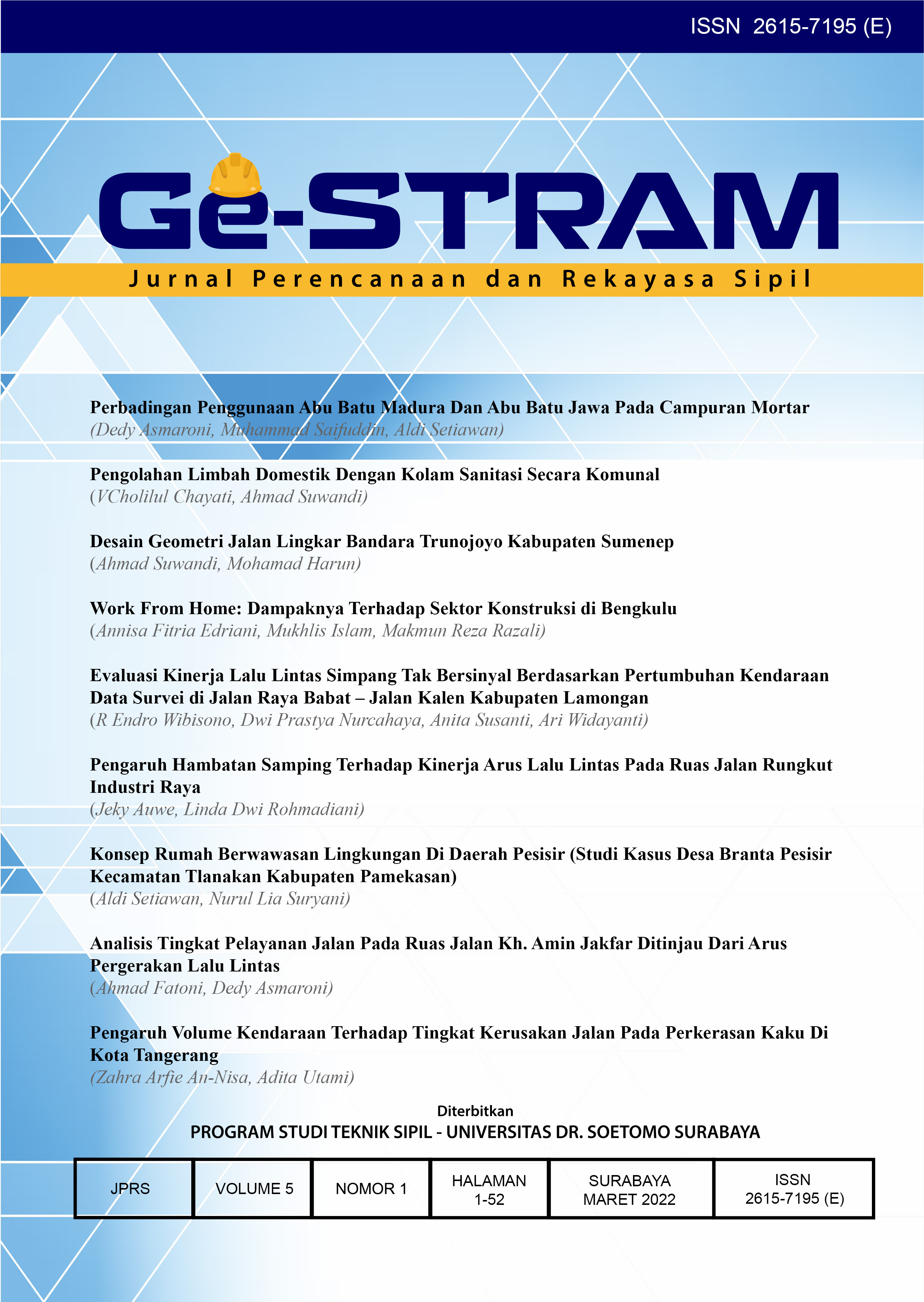Konsep Rumah Berwawasan Lingkungan di Daerah Pesisir (Studi Kasus Desa Branta Pesisir Kecamatan Tlanakan Kabupaten Pamekasan)
 Abstract views: 415
,
Abstract views: 415
,
 PDF downloads: 1072
PDF downloads: 1072
Abstract
The coast is an area that is located on the edge of the sea between the lowest and highest tides where the coastal area consists of land and water. Residential conditions in the village of Branta Pesisir which are classified as dense and have various buildings ranging from small to large and close to each other. The construction of houses that do not meet the correct rules causes the risk of fire and the spread of disease. This research is descriptive. The results showed that the largest house sizes were 5x6 m – 5x10 m. The most common land area found is 40-50 m². The number of family members is mostly 4 people. The most widely used building materials are white brick, wood, and flam tile. The highest house height is 2.5-3.00 m. Most houses do not have ventilation in every room. Access to sanitation is lacking and the remaining land for green open space is rarely found. The concept of an environmentally friendly house proposal is the largest house size by considering the layout, the presence of ventilation and green open space (RTH) which focuses more on the materials used, namely light brick, mild steel and metal roof tiles. The use of these materials is more efficient than the commonly used materials. The Estimated Budget Plan (RAB) proposed for environmentally friendly houses is more efficient than ordinary houses.
References
Adisasmita, HR. (2010). Pembangunan dan Tata Ruang. Yogyakarta: Graha Ilmu
Andrew, S. and William, K., (1978). “Lightweight Concrete” Applied Science Publishers Ltd. London.
Budihardjo, Eko; Hardjohubojo, Sudanti (1993). Kota Berwawasan Lingkungan. Bandung. Penerbit Alumni
David Heryyanto Simaela, Sonny Tilaar dan Fela Warouw (2019). “Analisis Morfologi Permukiman Di Kawasan Pesisir Kecamatan Tumpaan”. Jurnal Spasial Vol. 6 No. 3, 2019, Hal 637-645, Perencanaan Wilayah dan Kota Uiversitas Sam Ratulangi Manado, Manado.
Muhammad Aunirrouf dan Ronny Durrotun Nasihien (2019). “Analisa Dampak Perkembangan Pembangunan Infrastrukturterhadap Masyarakat Permukiman(Studi Kasus Jalan Pasar Nambangan, Kenjeran, Surabaya)”. Narotama Jurnal Teknik Sipil Vol. 3 No. 2, November 2019, Hal 11-18, Universitas Narotama, Surabaya.
Putu Indra Christiawan dan I Gede Budiarta (2017). “Entitas Permukiman Kumuh Di Wilayah Pesisir”. Jurnal Ilmu Sosial dan Humaniora Vol. 6 No. 2, Oktober 2017, Hal 178-187, Universitas Pendidikan Ganesha, Singaraja.
Renansiva, Revi (2006). “Kelayakan Baja Ringan”. [serial online]. http/www.bangunrumah.com. diakses tanggal 10 Januari 2022
Sufrin Sarman dan Karto Wijaya (2018). “Pola Permukiman Pesisir Pantai Studi Kasus: Desa Talaga 1 dan Desa Talaga 2 Kecamatan Talaga Raya Kabupaten Buton Tengah.” Jurnal Arsitektur Zonasi Vol. 1 No. 1, Juni 2018, Hal 38-44, Perencanaan Arsitektur dan Kota Universitas Pendidikan Indonesia, Bandung.
Theofilus Richard (2021). “Apa Saja Kelebihan dan Kekurangan Genteng Metal Pasir?” https://artikel.rumah123.com/apa-saja-kelebihan-dan-kekurangan-genteng-metal-pasir-56339. diakses pada tanggal 1 Februari 2022.
Copyright (c) 2022 Aldi Setiawan, Nurul Lia Suryani

This work is licensed under a Creative Commons Attribution-ShareAlike 4.0 International License.
Authors who publish with this journal agree to the following terms:
- Authors retain copyright and grant the journal right of first publication with the work simultaneously licensed under a Creative Commons Attribution-ShareAlike 4.0 International License that allows others to share the work with an acknowledgement of the work's authorship and initial publication in this journal.
- Authors are able to enter into separate, additional contractual arrangements for the non-exclusive distribution of the journal's published version of the work (e.g., post it to an institutional repository or publish it in a book), with an acknowledgement of its initial publication in this journal.
- Authors are permitted and encouraged to post their work online (e.g., in institutional repositories or on their website) prior to and during the submission process, as it can lead to productive exchanges, as well as earlier and greater citation of published work (See The Effect of Open Access).

This work is licensed under a Creative Commons Attribution-ShareAlike 4.0 International License.















